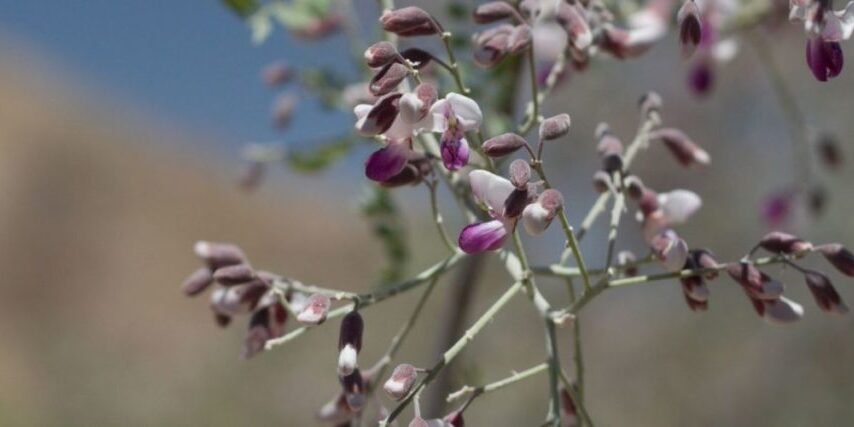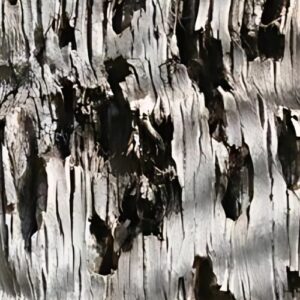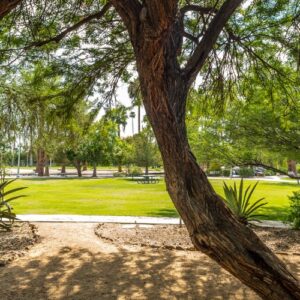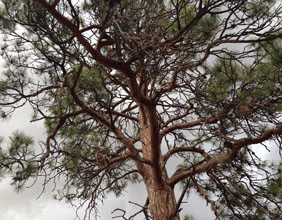
Lately, we’ve been getting a lot of questions about ironwood trees, and specifically about their spring flowers. Many residents of Anthem and surrounding areas don’t recall ever seeing ironwood trees in bloom. That’s not unusual, but that’s also not the only unique thing about our native ironwood trees.
In this article, we’ll cover some of the interesting facts about ironwood trees, whether you might want to add one to your property, all about their spring blooms, and more!
What is the official name for ironwood trees?
The official name for the trees we often call ironwoods is desert ironwood (Olneya tesota). It is also known as tesota and palo de hierro.
How did the desert ironwood get its name?
One reason may be that the wood of an ironwood tree is so dense that it cannot float in water. This dense wood also means that some of its tree rings are incomplete, or even missing.
When does desert ironwood bloom?
These trees bloom once a year in spring, usually in May.
Desert ironwood trees keep their spring flowers for less than a month, often only lasting for 10-18 days. No wonder some desert dwellers have never seen a flowering ironwood tree!
Do desert ironwood trees bloom every spring?
Desert ironwood trees do not bloom every spring. In fact, in a span of five years, they may only bloom twice.
Why do the ironwood flowers stand out so much?
Desert ironwood trees are almost evergreen, keeping their leaves for most of the year. However, the leaves on mature trees will turn yellow around April and then fall off right before the flowers appear. Green leaves re-appear with the summer rains.
The flowers can range from a white or light purple to deep purple, with darker blooms often seen on older trees.
Interestingly, only limbs that drop leaves will flower. Thanks to the lack of leaves, the purple blooms are highly visible and make an eye-catching statement in the landscape.
How long do ironwood trees live?
The lack of rings can make age determination difficult, but some ironwood trees can live more than 300 years. Even after dying, ironwood trees may take centuries to degrade because toxic chemicals in the wood prevent the tree from rotting. There are ironwood trees that have been dead for hundreds of years but are still standing!
What is the wood of ironwood trees used for?
The dense makeup of the wood is favored by wood carvers (though it can dull many tools!). It also makes excellent firewood. However, because too much firewood was harvested in the past, ironwood trees are now protected in Arizona and Sonora.
What are some distinctive features of the desert ironwood tree?
Desert ironwood trees grow to 35 feet tall and are covered with spines. They often have a short trunk and widely spreading branches. As mentioned earlier, these trees are almost always covered with leaves, which can be dark green and plentiful in times of rain or gray green and sparse in times of drought.
Does wildlife depend on this native tree?
Ironwood tree seeds are an important food source for a variety of animals in our area, such as doves, quail, and even coyotes. The seeds are available at a time when not many other food sources are available. Many types of animals will gather ironwood seeds and store them for later – leading to new ironwood tree seedlings if the buried seeds are forgotten.
The Arizona-Sonora Desert Museum states that desert ironwood trees impact over 500 other species of plants and animals. For example, desert ironwood trees are often “nurse plants” for other plants that need the protection, shade, and nutrients as they grow, such as our treasured saguaro cactus.
Are desert ironwoods fast-growing trees?
No, desert ironwoods grow incredibly slowly, which is why they have such strong, dense wood. Fast-growing trees tend to have brittle branches (think of blue palo verde trees, for example), but slow-growing trees have strong wood.
The ironwood tree is an extreme example of this. It can slow down growth during periods of drought, which allows it to hold on to water and other resources until conditions improve. One way it might slow its growth is by dropping some of its leaves to slow the process of photosynthesis (which requires lots of water and contributes to growth of the tree).
Are ironwood trees suited for the Anthem and Phoenix areas?
It depends. Ironwood trees can grow to 30-35 feet tall with around a 30-foot spread and are covered with spines. If you plant one, be sure you have enough space to give the tree room to grow and without nearby foot traffic (no one wants an up-close encounter with the spines!).
Desert ironwood is a popular desert landscaping tree that provides light shade and interest to any yard, and needs little water after it’s established. The tree needs full sun and slight pruning to remove suckers and water sprouts (which can develop if the tree receives too much water). There are no known pests or diseases that plague this native tree, and the branches are often tough and hardy, which is important during monsoons and microbursts.
If you’re considering planting an ironwood tree, read our article on how to choose and plant the right tree for your home.
Contact Titan Tree to see if an ironwood tree would suit your planting site.
More Articles Like This

Titan Tree Care is a full-service tree care company located in Anthem, AZ and serving all of North Phoenix. We offer a wide range of services to meet your tree care needs, including tree and palm trimming, tree pruning, tree removal, stump grinding, and more. We also offer insect or disease treatments and fertilization services. We are dedicated to providing high-quality, safe, and effective tree care services to our customers and work hard to ensure that your trees are healthy and look their best.









